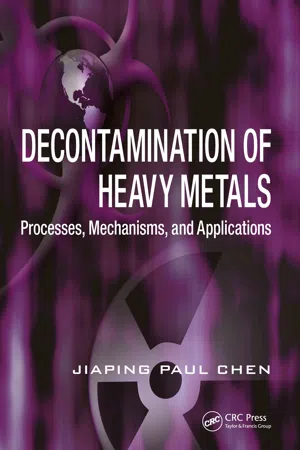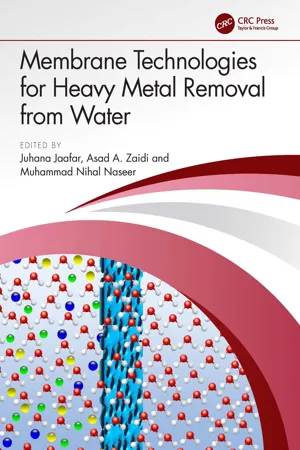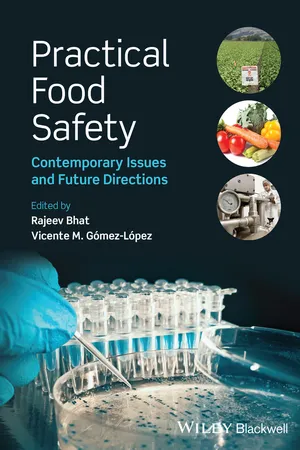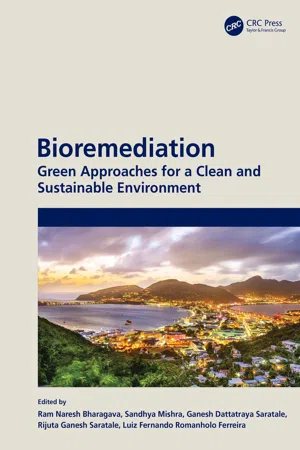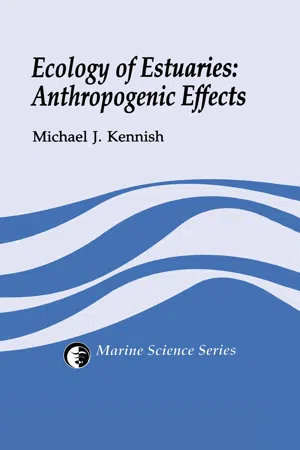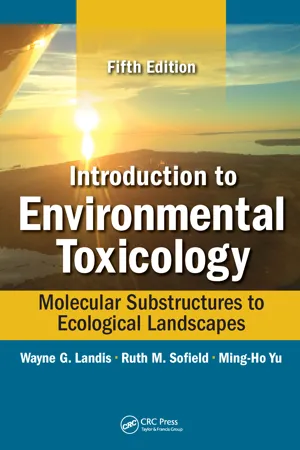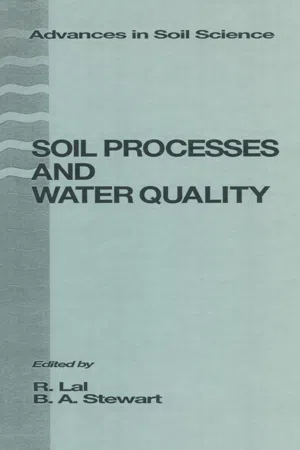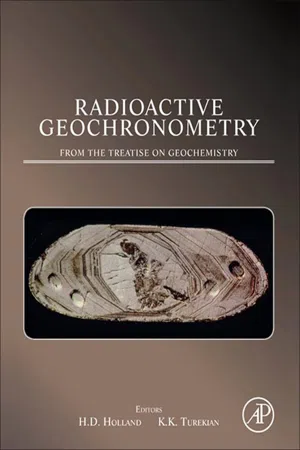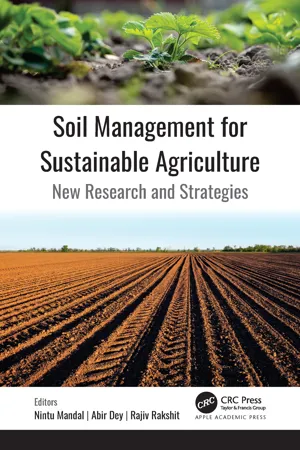Geography
Heavy Metals
Heavy metals are metallic elements with high atomic weights and densities, such as lead, mercury, and cadmium. They are naturally occurring in the Earth's crust but can also be released into the environment through human activities like mining and industrial processes. Heavy metals can accumulate in soil and water, posing risks to ecosystems and human health.
Written by Perlego with AI-assistance
Related key terms
Related key terms
1 of 4
Related key terms
1 of 3
12 Key excerpts on "Heavy Metals"
- eBook - ePub
Decontamination of Heavy Metals
Processes, Mechanisms, and Applications
- Jiaping Paul Chen(Author)
- 2012(Publication Date)
- CRC Press(Publisher)
1Occurrence and Importance ofHeavy Metal Contamination
1.1IntroductionMeteoric iron was perhaps the first metal that our forefathers encountered. Obviously, the hardness of metal became important to them for their survival. Metals have been used by human beings for more than 10,000 years. Copper products such as pins and awls, used around 7,000 to 9,000 years ago, were found in Ali Kosh of Western Iran and Cayönü Tepesi near Ergani in Anatolia. Beads of malachite and native copper were found in the Neolithic site of Cayonü Tepesi in southeastern Turkey, which dated back to 7250-6750 BC.1 Metalware, weapons, and farm tools have been needed for more than 5,000 years. Increasing demands have driven the exploration, extraction, and production of metals. In modern society, metal has found much wider applications, ranging from the tiny cellular phone chip to large spacecraft. It plays an essential role in our life.Heavy metal is a general collective term applied to the group of metals and metalloids with an atomic density greater than 5 g/cm3 . Another definition of heavy metal is that its molecular weight is above 40. Any metal with molecular weight less than 40 is called a light metal.Although both definitions are only loosely defined terms for Heavy Metals, they are widely recognized and usually applied to such elements as antimony, bismuth, cadmium, cerium, chromium, cobalt, copper, gallium, gold, iron, lead, manganese, mercury, nickel, platinum, silver, tellurium, thallium, tin, uranium, vanadium, and zinc. Most Heavy Metals (e.g., Cd, Cr, Cu, Hg, Ni, Pb, and Zn) are commonly associated with pollution and toxicity problems, particularly when they are present in soluble form. Sodium, potassium, calcium, and magnesium are light metals. - Juhana Jaafar, Asad A. Zaidi, Muhammad Nihal Naseer(Authors)
- 2024(Publication Date)
- CRC Press(Publisher)
Heavy Metals are classified as such because of their large atomic weight or density. They are harmful to both the environment and people. Some Heavy Metals, on the other hand, are rarely hazardous [ 4 ]. Heavy metal concentrations (see Figure 1.1) can be naturally high in some areas due to geogenic factors; some Heavy Metals are micronutrients, while others are non-essential Heavy Metals [ 5 ]. Heavy Metals are a unique class of contaminants found in water reservoirs. Because they do not filter themselves out of water but rather concentrate in reservoirs and penetrate the food chain, they have a strong ecological impact. Metal levels are frequently indicated by a surge in metal concentrations in a reservoir’s bottom sediment [ 6, 7 ]. Heavy metal contamination can be found in soil, water, and the atmosphere, among other places. Because of their substantial inhibitory effects on biodegradation activities, Heavy Metals are directly linked to environmental pollution and biological toxicity issues [ 8 ]. The presence of Heavy Metals in wastewater released from laboratories and industry is a major source of environmental concern. They are persistent environmental pollutants that cannot be completely biodegraded and must instead be converted into harmless forms. Streams become unsuitable when these metal ions are present in excess amounts in an aqueous discharge due to the negative effects associated with ingestion [ 9 ]. FIGURE 1.1 The correlation between an individual’s performance and the concentration of a heavy metal [ 15 ]. 1.1.1 Properties of Heavy Metals Most of the metals have a lower level of reactivity than lighter metals and usually have a higher density. In the Earth’s crust, they are comparatively scarce/less plentiful. They are incredibly tough and difficult to cut. Heavy Metals have a low thermal expansivity and a high tensile strength, and their melting points range from low to high- eBook - ePub
Practical Food Safety
Contemporary Issues and Future Directions
- Rajeev Bhat, Vicente M. Gómez-López, Rajeev Bhat, Vicente M. Gomez-Lopez(Authors)
- 2014(Publication Date)
- Wiley-Blackwell(Publisher)
12 Heavy Metals of Special Concern to Human Health and Environment Sameeh A. Mansour Environmental Toxicology Research Unit (ETRU), Pesticide Chemistry Department, National Research Centre, Cairo, EgyptSummary
Heavy Metals are natural components of the Earth’s crust and their excessive release in the environment is mainly due to human anthropogenic activities. These Heavy Metals cannot be degraded or destroyed and can easily enter the human body along the foods chains (via food, water, or air). Moreover, they have a tendency to accumulate in the human body, causing detrimental health effects even at minute concentrations. In this respect, Heavy Metals of special concern to human health and environment will be addressed.12.1 Introduction
The main threats to human health and environment from Heavy Metals are mainly associated with exposure to certain metals such as mercury, cadmium, lead, chromium, and arsenic. These metals have been extensively studied and their effects on human health regularly reviewed by international bodies such as the World Health Organization (WHO). Humans are responsible for the release of large quantities of metals, including arsenic (As), cadmium (Cd), chromium (Cr), lead (Pb), and mercury (Hg) into the environment (Nriagu and Pacyna, 1988). Once released, these metals are cycled between environmental media. Soils may become highly contaminated due to both direct land disposal of wastes and fallout from atmospheric emissions.Heavy Metals in particular have long residence times in soils because of sorption to soil particles (Fetter, 1992), which increases the potential risks for human exposure and adverse human health effects at both the cellular level (Delmas et al., 2000; Fulladosa et al., 2002) as well as higher levels (Stewart et al., 2003). Metal exposure to humans has been widely studied. Different populations show disproportionate susceptibilities to metals (Vahter et al., 2002). Infants and children are particularly susceptible to neurotoxicological damage from metal exposure due to their ongoing rapid intellectual development. The neurological systems of fetuses, often the target of damage from metals, are also at risk because of the transfer of maternal blood in which metals may bioaccumulate (Calderόn et al., 2003). Arsenic, chromium, and lead are three metals of particular concern for neurological impairment. A strong association was found between lower intelligence scores in Bangladeshi children and arsenic concentrations in drinking water after adjusting for social and economic factors (Wasserman et al., 2004). Chromium exposure, particularly from ingestion, can result in neurotoxic effects (Stewart et al., 2003). Thornton et al. (1990) found that lead blood levels of children were correlated with soil and dust lead levels in and around the home. Environmental lead exposure of pregnant women in Yugoslavia was also associated with lower intelligence test scores of their children (Factor-Litvak et al., 1999). Most exposure to metals is associated with contaminated groundwater and soils (Caussy et al. - eBook - ePub
Biological Inorganic Chemistry
A New Introduction to Molecular Structure and Function
- Robert R. Crichton(Author)
- 2012(Publication Date)
- Elsevier(Publisher)
Chapter 23
Metals in the Environment
Introduction Environmental Pollution and Heavy Metals Aluminium Cadmium Mercury Lead Metals as PoisonsIntroduction Environmental Pollution and Heavy Metals
We have already seen in earlier chapters that even essential metal ions can be toxic – as the historical father of toxicology, Paracelsus (1493–1541), wrote“Alle Ding’ sind Gift, und nichts ohn’ Gift; allein die Dosis macht, daß ein Ding kein Gift ist. ”“Everything is poisonous, and nothing is not; only the dose ensures that something is not poisonous. ”This dictum that “The dose makes the poison” is as true today as when it was stated five centuries ago. But it is also applicable to a number of metals which we encounter in our constantly evolving environment, many of which have no biological ‘raison d’être1 ’. These include a number of toxic metals which we have introduced into our environment in the course of the industrialisation of our society. Over the past decades, there has been an increasing awareness throughout the world of the health and developmental risks associated with environmental exposure to “Heavy Metals2 ”, such as lead (Pb), mercury (Hg), and cadmium (Cd). This term has been widely used, often to describe a group of metals and metalloids that have been associated with contamination and potential toxicity or ecotoxicity. At the same time, legal regulations often specify a list of “Heavy Metals” to which they apply. Such lists differ from one set of regulations to another and the term is sometimes used without even specifying which “Heavy Metals” are covered. However, there is no authoritative definition to be found in the relevant literature. And while we could agree that all of those mentioned above fall into the category of Heavy Metals that have been released into the environment by the activity of man, where do we place aluminium, the insidious pollution of which has crept upon us notably as a consequence of acid rain, as we pointed out in Chapter 1 - eBook - ePub
Bioremediation
Green Approaches for a Clean and Sustainable Environment
- Ram Naresh Bharagava, Sandhya Mishra, Ganesh Dattatraya Saratale, Rijuta Ganesh Saratale, Luiz Fernando Romanholo Ferreira, Ram Naresh Bharagava, Sandhya Mishra, Ganesh Dattatraya Saratale, Rijuta Ganesh Saratale, Luiz Fernando Romanholo Ferreira(Authors)
- 2022(Publication Date)
- CRC Press(Publisher)
The ever increasing population, industrialization and speedy urbanization are responsible for the release of a large number of pollutants in the environment. The disposal of pollutants from various industries, mining, vehicular pollution, lead–acid batteries, domestic waste and waste from agricultural practices has resulted in the contamination of soil, air and water. These wastes contain organic and inorganic substances, radionuclides and Heavy Metals. Heavy Metals are elements with high atomic weight and relatively high density in comparison with water. Heavy Metals released from natural and man-made sources are considered one of the major areas of interest by scientists and engineers as Heavy Metals are responsible for the degradation of environment and human health.The Heavy Metals chiefly considered hazardous are lead (Pb), cadmium (Cd), mercury (Hg), arsenic (As), chromium (Cr), nickel (Ni) and aluminium (Al). Metals such as Cu, Zn, Fe and Se play an important role in human metabolism at low concentration, but at higher concentration, cause severe damage to kidney and liver, anaemia, intestine and stomach pain, reduced reproductive fitness, development of carcinoma and finally death. Heavy Metals persist for a long period of time in the environment and inside organisms, which enhances their bioaccumulation and biomagnification. Mostly, humans, animals and fishes are badly affected from these metals as they are top consumers in food chain on land and in aquatic ecosystem, respectively (Sumiahadi and Acar 2018 ).Heavy Metals-contaminated sites are difficult to remediate. The conventional methods such as excavation, landfilling, thermal treatment and electro-reclamation are not appropriate due to high expenditure and low efficiency, and they result in residuals having toxic effects (secondary pollution). Bioremediation that utilizes various microbes, plant species or enzymes is a green, splendid alternative technique to transform toxic Heavy Metals into less toxic state for cleaning up of contaminated sites. It is the most cost-effective environmental management tool for the revival of environment (Shishir et al. 2019 - eBook - ePub
Ecology of Estuaries
Anthropogenic Effects
- Michael J. Kennish(Author)
- 2019(Publication Date)
- CRC Press(Publisher)
5 Heavy MetalsIntroduction
The continuous increase in heavy metal contamination of estuarine and coastal marine waters is directly attributable to industrialization and development in the coastal zone. The contamination by most Heavy Metals in coastal environments reflects localized impacts from point or multipoint discharges from municipal and industrial sources.1 Because of their persistence in the environment, their toxicity at high concentrations, and their tendency to accumulate in the tissues of biota, Heavy Metals pose potentially hazardous conditions for man. Hence, they have been the subject of ever-expanding research activities to control their concentrations in estuarine and coastal marine habitats.Heavy Metals, as defined by Viarengo,2 are a group of elements with atomic weights ranging from 63.546 to 200.590 and are characterized by similar electronic distribution in the external shell (e.g., Cu, Zn, Cd, and Hg). These exclude the alkaline earth metals, alkali metals, lanthanides, and actinides.3 Although these elements are toxic to estuarine and marine organisms above a threshold availability, many of them are essential to metabolism at lower concentrations.4 Necessary trace elements for life processes include (but are not limited to) cobalt, copper, iron, manganese, molybdenum, vanadium, strontium, and zinc;5 , 6 however, any of these elements can be toxic to organisms when present in high concentrations.7 Of great concern as potential environmental contaminants are cadmium, chromium, mercury, lead, selenium, arsenic, and antimony, which have contributed to severe insidious pollution problems in various estuarine and coastal ecosystems of the U.S. Some Heavy Metals, such as cadmium and lead, have no known biological function,3 - eBook - ePub
Introduction to Environmental Toxicology
Molecular Substructures to Ecological Landscapes, Fifth Edition
- Wayne Landis, Ruth Sofield, Ming-Ho Yu(Authors)
- 2017(Publication Date)
- CRC Press(Publisher)
CHAPTER 10 Metals 10.1 INTRODUCTIONPollution caused by metals is a worldwide phenomenon. Among the many metals, lead (Pb), mercury (Hg), cadmium (Cd), arsenic (As), chromium (Cr), zinc (Zn), and copper (Cu) are of most concern for toxicity, although the last three metals are also essential nutrients in animal and human nutrition. These metals are widely used in industry, particularly in metal working or metal plating, and in such products as batteries and electronics. They are also used in the production of jewelry, paint pigments, pottery glazes, inks, dyes, rubber, plastics, pesticides, and even in medicines.These metals are often referred to as Heavy Metals, although this terminology is imprecise, misleading, and a scientific consensus does not exist as to which metallic elements are Heavy Metals (Duffus 2002). Another term that is often used without scientific consensus is metalloid, which often includes elements such as arsenic that have intermediate properties between metals and solid nonmetals. From a toxicological perspective, chemical speciation is as important to consider as the metal; as discussed in Chapter 5 , a metal in the elemental form will have a different toxicity than the same metal complexed to an inorganic or organic ligand. In this chapter, we will refer to the elements of interest as metals and important speciation considerations will be addressed.Metals, such as those listed earlier, are relatively toxic because, as ions or in compound forms, they are soluble in water and may be readily absorbed into living organisms. After absorption, these metals can bind to vital cellular components such as structural proteins, enzymes, and nucleic acids, and interfere with their functioning. In humans, some of these metals, even in small amounts, can cause severe physiological and health effects. According to the Environmental Protection Agency (EPA) and the International Agency for Research on Cancer (IARC), many of the metals listed earlier are known as human carcinogens or probable human carcinogens (Tchounwou et al. 2012). - eBook - ePub
- B.A. Stewart(Author)
- 2020(Publication Date)
- CRC Press(Publisher)
Soil and Water Contamination by Heavy MetalsBal Ram Singh Eiliv Steinnes
I. Introduction II. Background Levels of Metals in Soils and Waters A. Heavy Metals in Soils B. Heavy Metals in Waters III. Anthropogenic Sources of Metals in Soils and Waters A. Fertilizers and Amendments B. Sewage Sludge C. Pesticides D. Industry and Mining E. Atmospheric Deposition IV. Soil Processes A. Weathering and Accumulation B. Soil pH and Redox Conditions C. Adsorption and Desorption D. Mobility and Transport E. Microbial Activity V. Heavy Metals in Water A. General Aspects B. Processes in Water C. Runoff Waters, Rivers and Streams D. Lakes E. Groundwater F. Fresh Water Sediments VI. Ecological Implications and Regulatory Control VII. Future Outlook and Research Needs ReferencesI. Introduction
In recent years, greater attention has been focused on Heavy Metals in soils and waters, partly because of scientific and public awareness of environmental issues, and partly because modern analytical techniques available for determination of very small quantities of these metals. In many parts of the world, particularly in the vicinity of urban and industrial areas, abnormally high concentrations of Heavy Metals have been reported. Some of these metals such as Cu, Zn, Mn, Fe, and perhaps also Cr are biologically essential and play an important role as cofactor in enzymatic processes.Others such as As, Cd, Pb, and Hg are not known to have any essential functions, but may create health problems when entering the food chain. Therefore, increased attention has been paid in recent decades to the monitoring and management of these non-essential but potentially toxic metals to prohibit their entry into the food chain. A number of cases of health problems related to environmental Cd and Hg poisoning, and elevated levels of Pb in the blood of infants have been reported. Of the various metals known mainly Cd, Cr, Co, Cu, Fe, Hg, Mn, Mo, Ni, Pb, Sn, and Zn are used in industry and out of them Cd, Cu, Hg, Ni, Pb, and Zn are considered most dangerous. In this paper attention will be paid to these Heavy Metals. In addition As and Cr, also sometimes associated with health problems, have been included. - eBook - ePub
Heavy Metals in Plants
Physiological to Molecular Approach
- Jitendra Kumar, Shweta Gaur, Prabhat Kumar Srivastava, Rohit Kumar Mishra, Sheo Mohan Prasad, Devendra Kumar Chauhan, Jitendra Kumar, Shweta Gaur, Prabhat Kumar Srivastava, Rohit Kumar Mishra, Sheo Mohan Prasad, Devendra Kumar Chauhan(Authors)
- 2022(Publication Date)
- CRC Press(Publisher)
1 Heavy Metals in our EcosystemRicha UpadhyayDepartment of Botany, Mihir Bhoj Postgraduate College, Dadri, G.B. Nagar-203207, U.P., IndiaEmail: [email protected]ABSTRACT
Heavy Metals pollution has become a global environmental issue as it has contaminated every sphere of the earth. Due to the increase in population with rapid growth in industrialization and urbanization metal contamination has increased at an alarming rate. Metal pollution is caused by both natural and human activities. Metals are not biodegradable, they are persistent in the environment, and tend to accumulate in the organism due to biomagnification. The metals contaminate all ecosystems, affect organisms residing in them, and eventually deteriorate human health through the successive transfer of metals in the entire food chain. Since plants can absorb Heavy Metals from both soil and water, metals hamper crop productivity and reduce its nutritional value. Thus, metal affects the health of human beings both directly and indirectly. This chapter explains the different sources of heavy metal, their forms and distribution in soil, the cycling of metals in the ecosystem, its trophic transfer through the food chain, its effect on the different ecosystems, crop productivity, and human health. This chapter comprehensively deals with the impact of Heavy Metals on the ecosystem in different contexts.1. Introduction
Heavy metal contamination has now become a global environmental issue. These metals can enter the ecosystem through multiple routes. Because of the tremendous increase in the use of metals in several fields viz; industry, agriculture, domestic, and technology, metals have disturbed several ecosystems and hampered the ecological balance (Masindi and Muedi, 2018 - eBook - ePub
Hazardous and Trace Materials in Soil and Plants
Sources, Effects, and Management
- M. Naeem, Tariq Aftab, Abid Ali Ansari, Sarvajeet Singh Gill, Anca Macovei(Authors)
- 2022(Publication Date)
- Academic Press(Publisher)
Heavy metal (HM) toxicity is a global concern and many countries and scientists are engaged in solving this problem. Although the presence of HMs around us is natural because they are also elements of nature but in excess concentration and the amount they behave like toxicants. The poisonous behavior of HMs harms environmental elements such as air, water, and soil along with affecting living beings too. It is quite easy for HMs to accumulate in soil via different processes. In routine life, we use several materials that consist of concentration of HMs and those, directly and indirectly, accumulate in the surrounding environment including soil. Once the soil is deposited with these toxicants, it becomes uneasy to remediate and takes a long time to re-establish the natural biota of soil. HMs via different pathways affect terrestrial and aquatic life. The present article focuses on major toxic HMs, their causes of accumulation in soil, the impact of accumulated HMs on the lives of plants and humans along with some remediation techniques to re-establish the soil ecology.Keywords
Heavy metal toxicity; environmental crisis; chemical fertilizers; industries; urban runoff; E-waste; plant and human lives; remediation techniques5.1 Introduction
Elements that have metallic properties along with heavy densities at least 5 gm cm−3 and heavy atomic weights (more than 23), atomic number (more than 20) (Canyon et al., 2013 ) and behave as a poison if over consumed, are considered as Heavy Metals. Heavy Metals (HMs) occupy the surrounding environment naturally such as soil erosion, natural weathering of earth’s crust, etc. and also through anthropogenic activities likes; industrial effluents, urban runoff, sewage discharge, chemical pesticides, etc. (Jaishankar, Tseten, Anbalagan, Mathew, & Beeregowda, 2014 ). Although a limited amount of HMs is required for the living organisms anything has a threshold value, above it, one can act as a poison. The excess amount of these HMs affects the lives of the ecosystem and is responsible for contamination of water and soil including damage of aqueous life, plants life and adversely affecting soil fertility.5.1.1 Listing of Heavy Metals
Metals of d-block, p-block, and f-block of the periodic table are known as Heavy Metals. These consist of transition metals, metalloids, lanthanides, and actinides (Singh, Gautam, Mishra, & Gupta, 2011 ). Chart 5.1 - eBook - ePub
Radioactive Geochronometry
A derivative of the Treatise on Geochemistry
- Heinrich D Holland, Karl K. Turekian(Authors)
- 2010(Publication Date)
- Academic Press(Publisher)
Kersten and Forstner, 1995 ). This may not be too surprising as exchangeable metals are released once freshwater mixes with salt water and redistribution in the marine environment results in some precipitated phases (carbonates, Fe/Mn oxyhydroxides) and the relative increase in the lithogenic fraction. In future, the solid-phase identification techniques should be used to classify the sediments that are to be subjected to “selective” extraction techniques for the purpose of understanding the heavy metal phase associations.15.3 ATMOSPHERIC EMISSIONS OF METALS AND GEOCHEMICAL CYCLES
Both natural and perturbed geochemical cycles include several subcycle elements, not the least of which is the emission of metals into the atmosphere. Atmospheric metals deposited on the land and ocean surface are a part of the runoff from land into the ocean and become incorporated in marine sediments. Thus, the two major pathways whereby Heavy Metals are injected into the natural geochemical cycles are atmospheric and fluvial. Considering the land surface, atmospheric emissions from stationary and mobile facilities and aqueous emissions from manufacturing and sewage disposal facilities are the primary sources of heavy metal contamination. As for the ocean, atmospheric deposition and continental runoff are the primary inputs.Duce et al. (1991)summarized the global inputs of metals to the ocean for the 1980s and these data are presented in Table 6 . Riverine inputs are substantially greater than the atmospheric inputs, especially particulate riverine inputs that account for 95% of the total (Chester, 2000 ). For Pb and Zn, riverine inputs are 20 and 30 times greater than the corresponding atmospheric inputs. For Cd the factor is only 5, while for Cu and Ni the factors are 45 and 30, respectively. Global atmospheric inputs to land and ocean for the same time period are substantially greater (2–3 times, Table 6 ) than atmospheric deposition to the ocean. This is due to the presence of major pollution sources (mining, smelting, fossil-fuel combustion, waste incineration, manufacturing facilities) on the land masses. In fact, for Pb during the 1970s and 1980s, the use of leaded gasoline in vehicles resulted in the emission of four times the metal to the land surface compared to the ocean (Table 6 - eBook - ePub
Soil Management for Sustainable Agriculture
New Research and Strategies
- Nintu Mandal, Abir Dey, Rajiv Rakshit(Authors)
- 2022(Publication Date)
- Apple Academic Press(Publisher)
Datta et al., 2017 ). Therefore, a combined effort of assessing the severity of contamination, time-to-time monitoring along with proper remediation, is the need of the hour to judge the suitability of land for agricultural activities as well as to prevent food chain contamination. This chapter has engrossed on the sources of metal and metalloid pollution in soil along with possible remediation measures.20.2 HEAVY METAL SOURCES IN SOIL
Various geogenic processes are primarily accountable for natural occurrence of Heavy Metals in trace amounts in soils (Kabata-Pendias and Pendias, 2001 ; Pierzynski et al., 2000 ). The numerous pathways of metals and metalloids in the soil is represented schematically in Figure 20.1 .FIGURE 20.1 Pathways of metals and metalloids in the soil.20.2.1 GEOGENIC SOURCES
The process of weathering of rocks (igneous and sedimentary), minerals, and parent materials and also to some extent coal are the prime cause of Heavy Metals and metalloids in nature. Arsenic is dominated in sulfide-bearing minerals especially in iron ores. Arsenopyrites, realgar, and orpiment are some of the minerals which serve as a source of arsenic. The formation of sedimentary rocks mainly contributes toward arsenic enrichment of the Fe–OH and sulfides. It is due to the precipitation of the hydroxides and sulfides of iron. Therefore, iron deposits and iron ores of sedimentary origin are rich in arsenic and may attain a value greater than 20 mg kg−1 . Arsenic contamination of the groundwater is mainly from geological sources, that is, through reductive dissolution of arsenopyrite minerals and has created havoc in countries like India, Bangladesh, China, and Mexico. Cadmium (Cd) content fluctuates with the categories of parent materials. The soils originated from the basaltic rocks contain more cadmium compared to that originated from the granites. Soils free from pollution generally contain 0.01 to 30 mg kg−1 of total Cd with a mean range value of 0.06 to 0.5 mg kg−1 (Page et al., 1981 ; Alloway, 1995 ). Lead (Pb) content in the lithosphere is estimated at 16 mg kg−1 , and the total Pb content of agricultural soils lies between 2 and 200 mg kg−1 . Soils with levels in excess of this are restricted to a comparatively few areas of India where depositions of Pb minerals are found. Most soils contain trace amount of nickel (Ni), usually less than 100 mg kg−1 , and pretty close at which Ni toxicity occurs. The soils originated from ultra-basic igneous rocks and predominantly serpentine, however, contain 20–40 times this amount and nickel toxicity can be observed in plants. In the earth’s crust, the mean chromium (Cr) content is 125 mg kg−1 with a range of 80–200 mg kg−1 (National Academy of Sciences, NAS, 1974
Index pages curate the most relevant extracts from our library of academic textbooks. They’ve been created using an in-house natural language model (NLM), each adding context and meaning to key research topics.
Explore more topic indexes
Explore more topic indexes
1 of 6
Explore more topic indexes
1 of 4
